The legendary Rich Piana was generally in bulking mode, which meant he was usually on a diet that included carbohydrates. However, when it came to shredding, Rich knew the power of the keto diet, as discussed in this video below:
Utilizing ketones while eating like Rich Piana on a bulk?
Rich loved ultra low-carb diets for shredding, but needed carbs to build. What if there was a way to get some of the benefits of the keto diet without ditching the carbs?
You can with exogenous ketones. If you're a low-carb dieter, get ready for some extra ketones. And if you're a carbohydrate user, get ready for some dual energy:
5% Nutrition's Keto aSALT: Exogenous Ketones for Everyone
Keto aSALT from 5% Nutrition consists mostly of goBHB, a patented set of ketone salts manufactured by the scientists at NNB Nutrition and licensed from Axcess Global. Keto aSALT uses goBHB's calcium beta-hydroxybutyrate, sodium beta-hydroxybutyrate, and magnesium beta-hydroxybutyrate trihydrate, totaling a dosage of 11.7 grams.
Astute readers will note that all three of these salts have beta-hydroxybutyrate (BHB) in common. As you will see, BHB is one of three major ketone bodies — and probably the best studied.
Whether you're looking for a bump to your ketone levels, or want to feel the alternative energy of ketones while doubling down on carbs, the goBHB-powered Keto aSALT is a supplement well worth trying.
Be sure to read through to the end because we'll touch on the other supporting ingredients in this supplement. We'll start by diving into what ketones are and how they can benefit the human body, but first, let's check in on Keto aSALT's prices and availability:
Rich Piana 5% Nutrition Keto aSALT – Deals and Price Drop Alerts
Get Price Alerts
No spam, no scams.
Disclosure: PricePlow relies on pricing from stores with which we have a business relationship. We work hard to keep pricing current, but you may find a better offer.
Posts are sponsored in part by the retailers and/or brands listed on this page.
Ketones: What they are and what they do
Most contemporary Americans eat the "standard American diet," aptly abbreviated as SAD.
The SAD contains, among many other (sometimes worse) ingredients, a fairly large proportion of carbohydrates, meaning that people who eat the SAD are more or less constantly burning glucose for energy. Because glucose is the human body's preferred energy source, and especially the brain's,[1,2] continually consuming carbs means that your body will always be in the process of burning them off for energy.
Of course, for much of human evolutionary history, carbohydrates were not as easily accessible year round. It was the rise of agriculture, circa 10,000 B.C., that made grains and legumes the perennial staples of human nutrition.
In regions where ancestral hunter-gatherer societies could only harvest carbohydrates seasonally, their metabolisms were forced to adapt largely (and sometimes almost entirely) to an alternative source of fuel: namely, fat.
Sometimes, this was dietary fat ingested from consuming hunted animals. As an example, take the traditional Inuit diet that consists almost entirely of tip-to-tail animal nutrition.[3] That's because in the frigid Arctic Circle, plant foods and dietary carbohydrates are extremely few and far between.
In more temperate regions, in the wintertime, human beings subsisted largely on their own stored body fat, which is why we have evolutionarily-preserved mechanisms for fattening-up during the warm months, such as the upregulation of stearoyl-CoA desaturase (SCD) by fructose consumption.[4] Since SCD desaturates body fat, making us insulin resistant and thus predisposed to fat gain, it's been theorized that eating lots of ripe fruit high in fructose during warm months was one way for our ancestors to store energy for the winter.
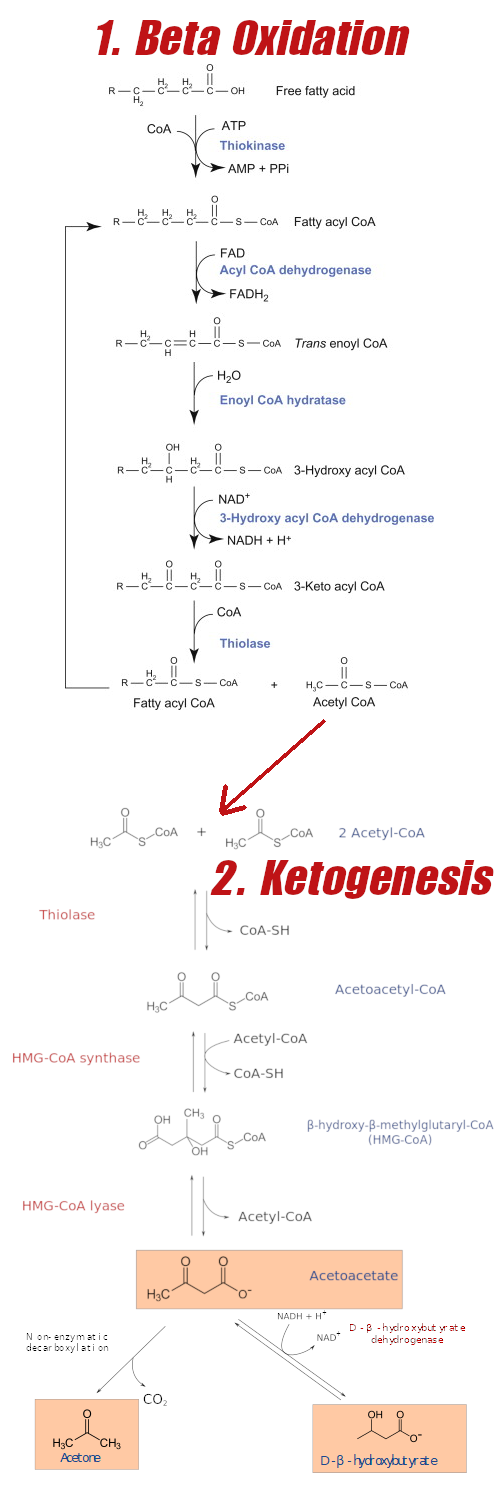
Beta Oxidation of fatty acids leading to Ketogenesis. BHB is the primary ketone made that the body can use as an energy substrate. We can add more BHB for various reasons, since this fat burning process is slower and you may wish to have some BHB available immediately for more energy.
Oxidizing — or burning — body fat for energy is carried out by a process called beta-oxidation. It produces ketone bodies[5] that can be burned for energy by every type of cell in the body, including the brain.[6]
The three types of ketones are:
- Beta-hydroxybutyrate
- Acetoacetate
- Acetone
These ketones are produced mostly by mitochondria in the liver.[7] Under normal circumstances (i.e. for someone who's eating the SAD), they're burned for energy by the body during extended fasts and during exercise intense enough to deplete glycogen stores.
However, even moderns can induce the burning of ketones for energy if they so choose, simply by restricting dietary carbohydrate intake.[8-10] This is called nutritional ketosis.
Keto diet: "Biohacking" our way to better metabolic health
Anyone who wants to induce nutritional ketosis should consider following the ketogenic diet. Often referred to as "keto" for short, this diet is a strategy for forcing the body to burn ketones as fuel instead of glucose.
Keto "ways of eating" (an alternative to "diet", if one wishes to avoid weight loss connotations) are characterized by extremely restricted dietary carbohydrate intake. Keto dieters often aim for 0% calories from carbs. The generally accepted threshold for carbohydrate intake if one wishes to induce and remain in ketosis, the state of endogenously producing ketones, is 5% to 10% or less of total calories from carbs.
Keto dieters also often use intermittent fasting or extended water fasts to ramp up their production of ketones, a practice with a multitude of potential health benefits[11] that are still being investigated. The basic idea here is that fasting can force your body to produce ketones from your own stored body fat.
The keto diet has exploded in popularity during the last decade, owing to its documented ability to normalize blood sugar and insulin levels,[12,13] improve markers of cardiometabolic health,[14-16] produce fat loss,[17-19] improve liver health,[20] and more.[21-24]
One groundbreaking study published in 2008 found that a whopping 95% of participants with type 2 diabetes were able to reduce or discontinue their medication within six months of adopting a ketogenic diet.[25] The famous Virta Health study, released in 2019, reached similar conclusions.[26-28]
In the long run, people who eat keto actually have a higher basal metabolic rate than glucose burners,[29,30] and less visceral fat (sometimes referred to as trunk fat),[31] a type of body fat that surrounds internal organs and is considered a major risk factor for the metabolic syndrome that's a precursor to type 2 diabetes.[32]
Although all of this seemed novel to most Americans in the 2010s, the reality is that fasting and the ketogenic diets have been used medicinally for thousands of years.[33] The diet was even prescribed by allopathic medical doctors starting in the 1920s, until the ideologically-driven nutritional "science" of the 1970s caused it to fall out of fashion.

Rich Piana's persistence was hard to beat. One thing that kept him publishing YouTube after YouTube was his flexibility with diet.
Where do the benefits of the ketogenic diet come from?
One of the most common questions about the ketogenic diet is: Is the elimination of carbohydrates from the diet and the normalization of insulin production what makes the ketogenic diet therapeutic, or do the ketones themselves have therapeutic properties as well?
The answer is probably both.
If the ketones themselves are helpful, then the next question is: What benefit, if any, do we get from ketone supplementation?
Exogenous ketones: Benefits
5% Nutrition Keto aSALT contains 11.7 grams of total goBHB. Let's look at some data to see the benefits of these molecules:
Some of the earliest research on exogenous ketones goes back to the 1990s. Researchers discovered that the nutrient, when supplied from an external source, could improve energy availability during exercise, reducing lactate formation while boosting overall performance.[34] The mechanism by which ketones accomplish this appears to be their glucose-sparing ability, since they're able to serve as an alternate fuel source during exertion.
From this finding was derived a long line of research into exogenous ketone supplementation for athletic performance, especially for endurance athletes. Nonetheless, as we'll demonstrate, the non-athletic benefits of ketones are at least as exciting as the athletic ones.
-
Endurance athletics
A few studies have been done that have tested the use of exogenous ketones during athletic performance. Generally speaking, ketones produced outside of the body don't do much to increase anaerobic performance,[35,36] but can significantly boost aerobic endurance[37] by reducing lactic acid buildup(a byproduct of glucose metabolism).[38] Exogenous ketones can also help reduce temporary cognitive impairment that typically follows the completion of intense exercise.[36]
-
Reduced appetite
A 2017 study found that an exogenous ketone drink reduced appetite, insulin levels, and ghrelin levels in subjects who consumed it.[39] Ghrelin happens to be known as "the hunger hormone" for its ability to induce appetite. So lower ghrelin levels should lead to reduced appetite, which would be a vindication of what many exogenous ketone users have anecdotally reported for many years.
Since ghrelin rises in response to stress,[40] exogenous ketones can be especially helpful during stressful episodes by virtue of preventing stress-induced overeating, something with which most of us are undoubtedly all too familiar.
Can exogenous ketones produce fat loss?
The research on exogenous ketones and fat loss is in its infancy, but there is one intriguing animal study from 2019. Overweight mice that were on an ad libitum high-fat diet for 10 weeks showed increased metabolic rate and lower body fat levels after taking exogenous ketones for three months.[41]
-
Anxiety and cognition
There's another reason why you might consider reaching for the ketones when you're feeling stressed: two different preclinical studies have found that exogenous ketones have anti-anxiety effects. In both of these studies, researchers found that animals who took ketones displayed fewer anxiety-related behaviors than animals who didn't.[42,43] In one of these studies, mice with an Alzheimer's-like disease performed better on cognitive tests after taking exogenous ketones compared to mice who were fed carbohydrates.[42]
-
Cardiovascular benefits
One 2017 study found that exogenous ketones reduced glucose, free fatty acid, and triglyceride blood levels.[44] Another found that 18 to 35 year olds who supplemented with ketone salts for six weeks had lower blood pressure than those who took a placebo instead.[45]
Another study published in 2017 found that long-term oral supplementation with beta-hydroxybutyrate (BHB), a type of exogenous ketone, improved blood lipids and decreased visceral fat levels in rats.[46] Specifically, this study found that the BHB rats had higher "good" HDL cholesterol and lower triglycerides – a far more important metric for cardiovascular health than the "bad" LDL cholesterol levels alone. However, the BHB rats also had lower LDL levels,[46] which still could be of importance to some.
This and much more are covered in our recent article titled Innovating BHB: NNB Nutrition and the Brains Behind Ketone Supplements.
Other ingredients in 5% Keto aSALT
11.7 grams of BHB salts aren't the only thing in Keto aSALT from 5% Nutrition. Let's briefly take a look at the three additional ingredients in this formula.
-
L-Carnitine L-Tartrate – 200 mg
Carnitine is one of PricePlow's favorite ingredients. It plays a big role in cellular energy production by moving fatty acids into our cells' mitochondria, organelles responsible for producing adenosine triphosphate (ATP).[47] Since ATP is the energy currency of the body, this makes carnitine very important for optimizing metabolic function and overall health.
Carnitine is categorized as a conditionally essential amino acid, which means that although the body can produce some carnitine on its own, it can't produce enough to optimize carnitine levels or carnitine-related processes. In other words, it behooves us to get more carnitine from food and supplements.
Of course, not everybody's carnitine requirement is the same. According to the latest research, there are three groups of people who are most at risk of not getting enough carnitine:
- Vegans and vegetarians typically don't get enough carnitine from food[48-51]
- Elderly people tend to be carnitine-depleted from age-related metabolic dysfunction[52,53]
- Athletes consume carnitine at an elevated rate during exercise[54]
If you're an athlete, you should definitely consider carnitine supplementation: especially if you're a plant-based dieter.
The tartate form of carnitine has been shown to increase androgen receptor density in men who take it.[54] Plus, it can amplify the effects of testosterone in the body.
This is a small dosage, but one that can still support mitochondria a bit to synergize with the BHB. Our take is that carnitine is an ingredient where anything is better than zero. The clinical daily doses for carnitine supplements themselves is generally 2 grams per day -- if you want that (and more), then check out 5% Nutrition's Liquid L-Carnitine 3150.
There's a lot to say about carnitine, so if you want to learn more, follow this link to an in-depth discussion on the topic: L-Carnitine is Underrated. New Meta Review Reminds Us Why.
-
Coenzyme Q10 – 25 mg
Coenzyme Q10 (CoQ10) is a fat-soluble antioxidant that occurs naturally in animals. In humans, the compound is highly concentrated in mitochondria where it facilitates the action of the electron transport chain that ultimately produces all of our body's energy in the form of adenosine triphosphate (ATP).[55] ATP is consumed in all metabolic processes, which is why CoQ10 is often considered essential for the health of all organs and tissues.[55]
The man's legendary status would have persevered regardless, but 5% Nutrition is putting together some fantastic supplements to keep Rich Piana's legacy going strong!
A powerful antioxidant, CoQ10 helps reduce the formation of free radicals (sometimes known as reactive oxygen species, or ROS) and thereby prevents damage to DNA, proteins, and lipids. In recent years, scientists have linked chronic disease to high levels of ROS and low levels of CoQ10, implying that a deficiency might lead to chronic disease.[55]
Researchers believe that supplementing with CoQ10 may be beneficial to patients diagnosed with any one of these potentially debilitating medical conditions:[55]
- Cardiovascular disease
- Hypertension
- Gum disease
- Mitochondrial dysfunction
- Obesity
- Type 2 diabetes
- Parkinson's disease
- Stomach ulcers
- Kidney disease
Additionally, increased ATP production from CoQ10 saturation may improve mental and physical performance.[55] This should synergize with BHB quite well, and not many brands are doing this.
Note: for maximum absorption, fat-soluble ingredients should always be consumed with or after dietary fat.
-
Potassium citrate – 89 mg
Keto 5% aSalt also contains a relatively small dose of potassium, intended to serve as trace electrolyte supplementation. This ingredient can be important for keto dieters as this regimen, particularly, is often associated with dehydration and electrolyte imbalance.[56]
Flavors available
Conclusion: Not just for keto dieters
We get it - most 5% Nutrition athletes are usually bulking, using products like KILL IT Reloaded, Crea-TEN, and 5% TEST while sipping on ALL DAY YOU MAY. But when you're bulking - which often incorporates carbs (see Rich Piana's REAL CARBS supplement) - you're not going to be generating appreciable amounts of the other energy source -- ketone bodies!
The biggest thing we want to emphasize is that these supplements aren't just for dieters. While they're helpful to push the transition into ketosis for low-carb dieters, priming the mitochondria for the ketone storm that's to come, that's not all they do. As an alternative fuel source for the brain and body, they generally feel very good, and may aid in performance for all kinds of athletes - not just carb-starved ones.
So if you're looking for a bit more energy to your game, and have topped out your stimulant doses, take a look at ketone bodies. Your mitochondria just may thank you.
Rich Piana 5% Nutrition Keto aSALT – Deals and Price Drop Alerts
Get Price Alerts
No spam, no scams.
Disclosure: PricePlow relies on pricing from stores with which we have a business relationship. We work hard to keep pricing current, but you may find a better offer.
Posts are sponsored in part by the retailers and/or brands listed on this page.
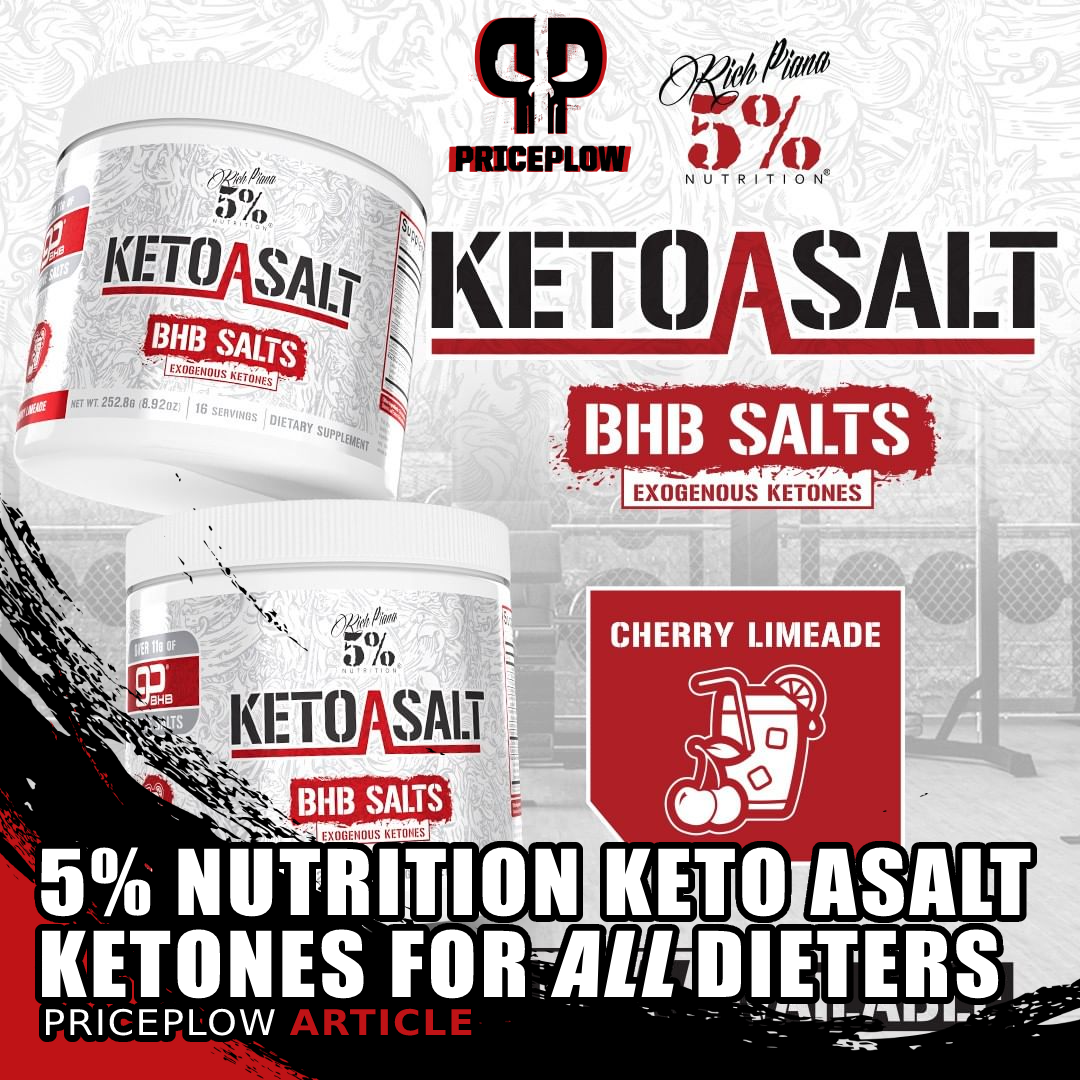
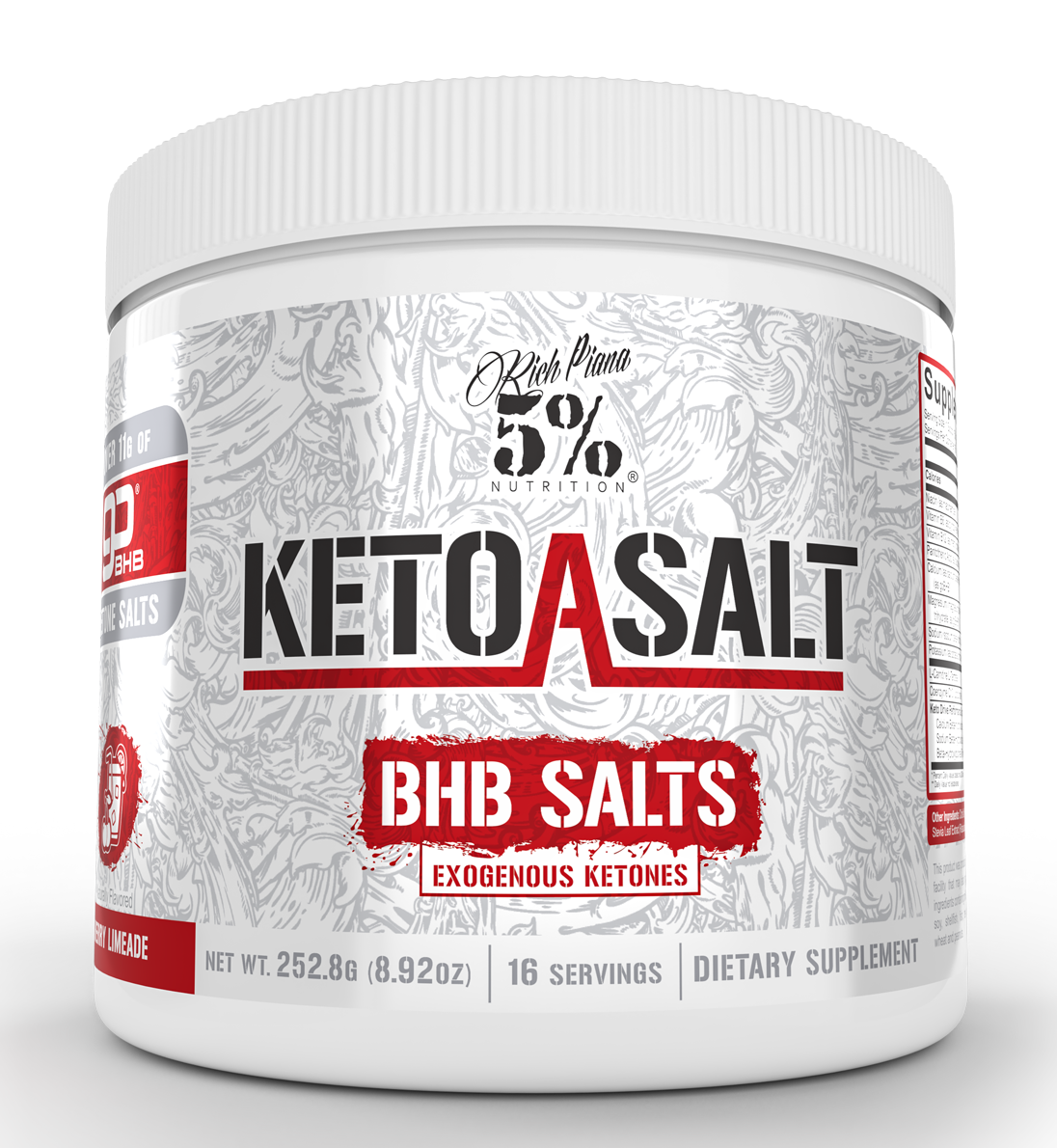
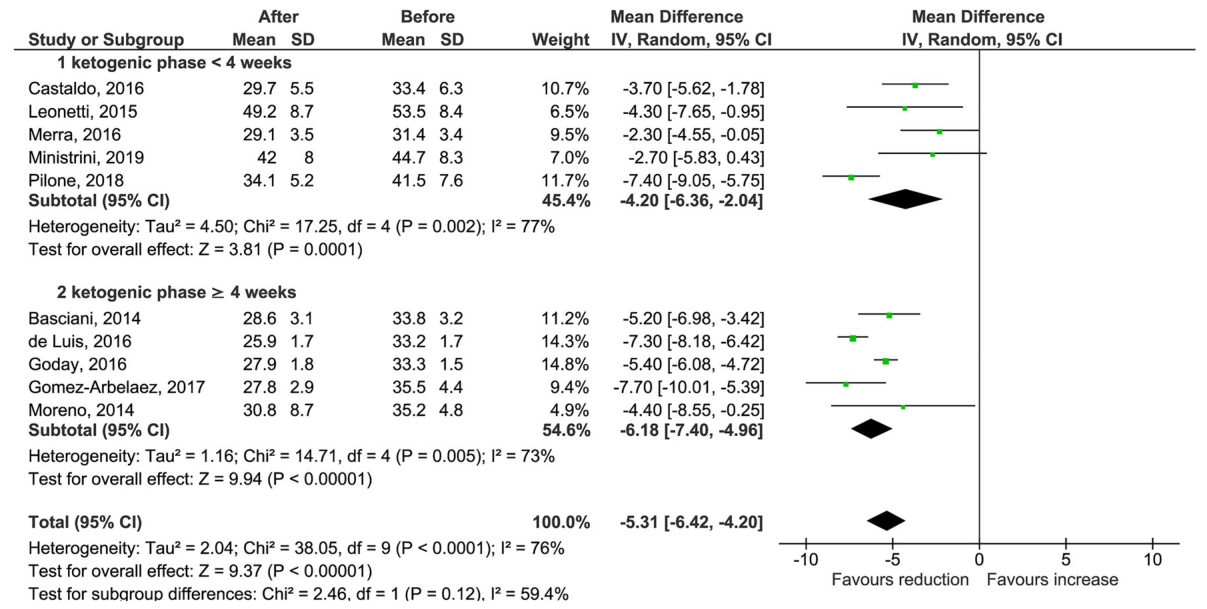
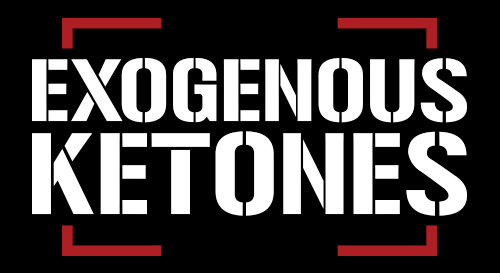



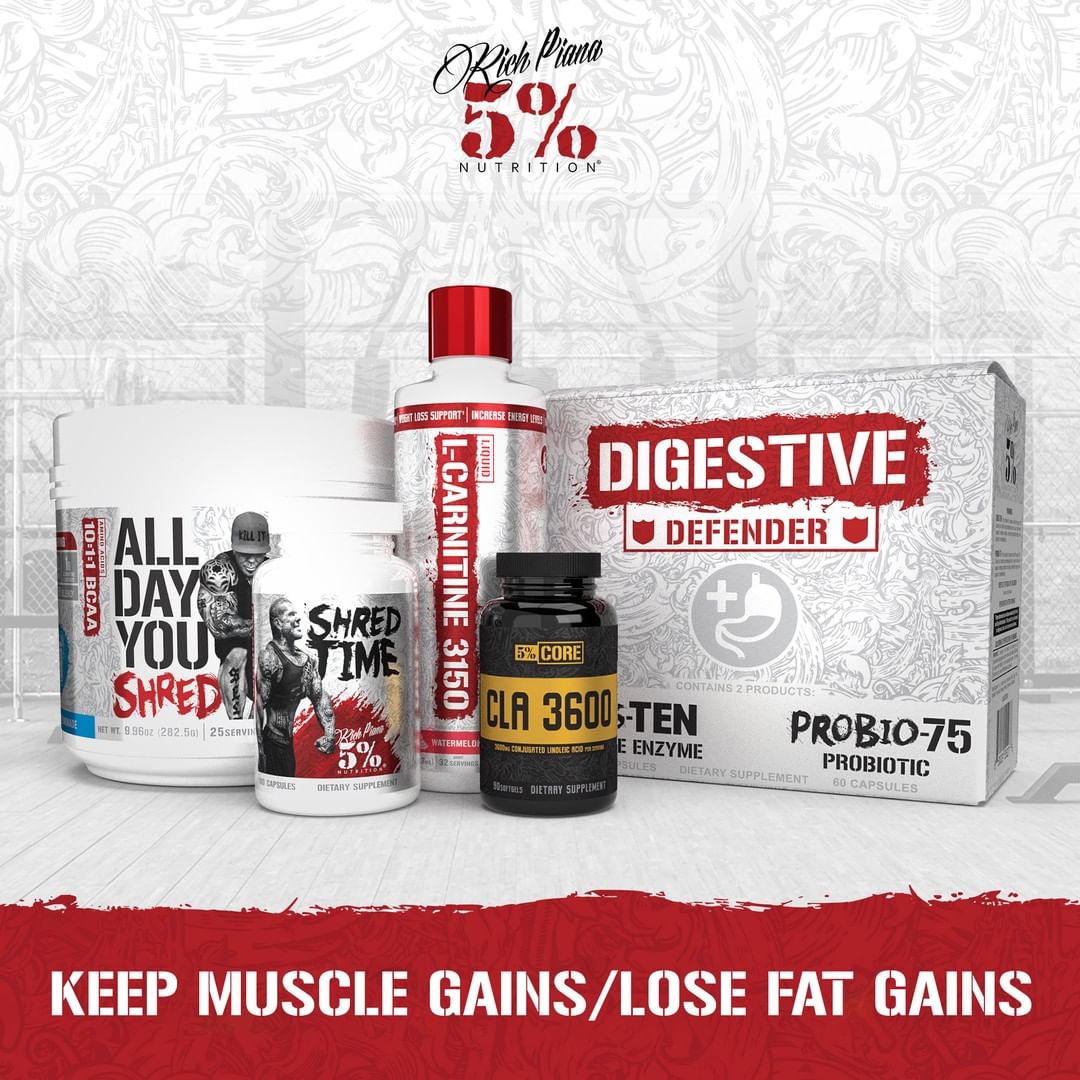





Comments and Discussion (Powered by the PricePlow Forum)